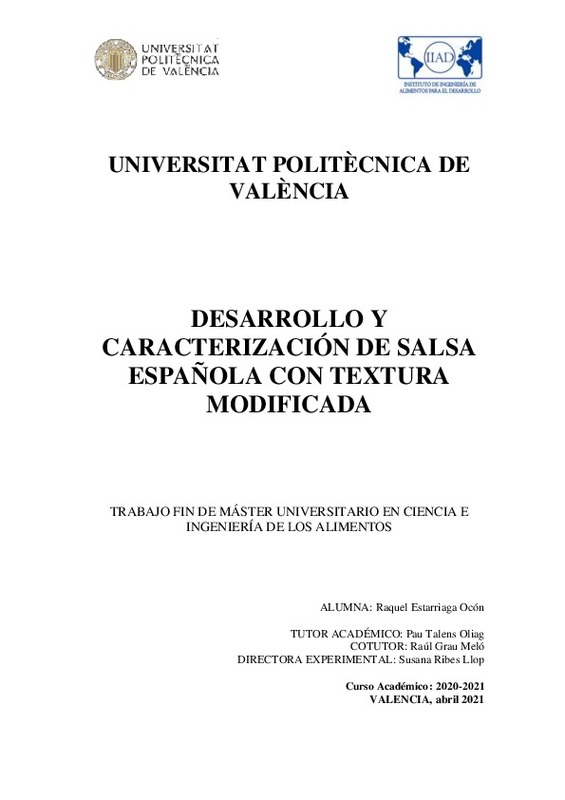|
Resumen:
|
[ES] En el presente trabajo se estudiaron las propiedades fisicoquímicas, reológicas, viscoelásticas, masticatorias y sensoriales, en presencia y ausencia de saliva, de una salsa española con textura modificada a 25, 37 y ...[+]
[ES] En el presente trabajo se estudiaron las propiedades fisicoquímicas, reológicas, viscoelásticas, masticatorias y sensoriales, en presencia y ausencia de saliva, de una salsa española con textura modificada a 25, 37 y 55° C. La textura de las muestras fue modificada mediante el uso de cinco hidrocoloides (NutAvant® (NA), goma guar (GG), goma tara (GT), carboximetilcelulosa sódica (CMC) y mucílago de semillas de chía (CSM)). Se obtuvieron dos niveles de consistencia (miel y pudin). Las salsas elaboradas con NA, GG, GT y CSM presentaron mayor consistencia, firmeza, rigidez y resistencia al flujo que las muestras preparadas con CMC. Además, la estructura interna de la salsa espesada con CMC fue la más afectada por los cambios de temperatura. El uso de saliva disminuyó la viscosidad aparente, la consistencia y la adhesividad de las salsas. Entre las muestras evaluadas, las salsas espesadas con GG y CSM podrían ser más apropiadas para personas con problemas de deglución o disfagia debido a su grado de elasticidad, su alta resistencia a la deformación y estabilidad estructural. Sin embargo, las salsas elaboradas con CSM mostraron la puntuación más baja en relación a los distintos atributos sensoriales evaluados. Este trabajo confirma la importancia del tipo de hidrocoloide y el nivel de consistencia seleccionados, así como la temperatura de administración de los productos orientados a pacientes con problemas de deglución o disfagia.
[-]
[EN] In the present work, the physicochemical, rheological, viscoelastic, masticatory and sensory properties, in the presence and absence of saliva, of texture-modified Spanish sauce at 25, 37 and 55 °C were studied. The ...[+]
[EN] In the present work, the physicochemical, rheological, viscoelastic, masticatory and sensory properties, in the presence and absence of saliva, of texture-modified Spanish sauce at 25, 37 and 55 °C were studied. The texture of the samples was modified by using five different hydrocolloids (NutAvant® (NA), guar gum (GG), tara gum (GT), sodium carboxymethylcellulose (CMC) and chia seed mucilage (CSM)), and two thick levels (honey-thick and pudding-thick) were obtained. The sauces prepared with NA, GG, GT and CSM presented higher consistency, firmness, stiffness and flow resistance than the samples prepared with CMC. In addition, the internal structure of CMC-thickened sauces was the most affected by temperature changes. The use of saliva decreased the apparent viscosity, consistency and adhesiveness of the sauces. Among the samples evaluated, sauces thickened with GG and CSM could be more appropriate for people with swallowing problems or dysphagia due to their degree of elasticity, high deformation resistance and structural stability. However, sauces made with CSM showed the lowest sensory attributes scores. This work confirms the importance of considering the hydrocolloids type and the level of consistency, as well as the temperature of administration of products oriented to patients with swallowing problems or dysphagia.
[-]
|







